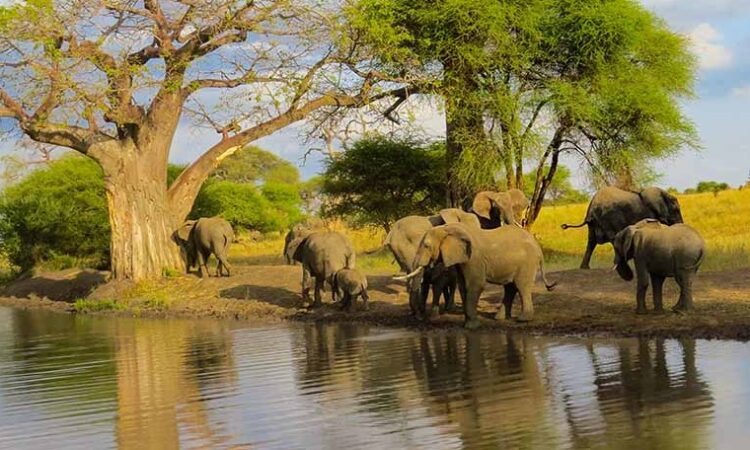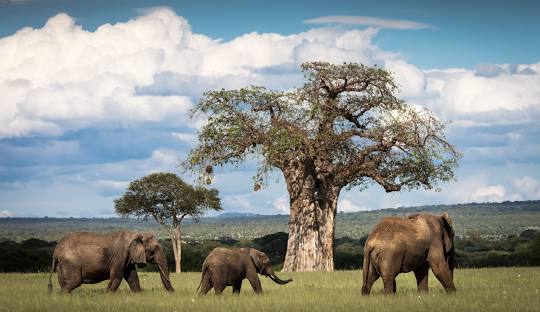
All About Tarangire National Park
All About Tarangire National Park
The northern Tanzanian region contains the authentic safari destination of Tarangire National Park, which attracts fewer visitors than popular areas. Tarangire National Park stands out for its substantial elephant populations alongside its baobab landmarks and diverse wildlife, which belongs to Tanzania’s northern safari circuit together with Serengeti National Park, Ngorongoro Crater, and Lake Manyara. The dry season brings a special appeal to Tarangire National Park as its wildlife densities match levels seen in more well-known parks.
The geographic position of Tarangire National Park exists in Tanzania.
The location of Tarangire National Park 118 kilometers southwest of Arusha enables it to function as an attractive starting point or finishing point for northern Tanzania tours. The 2,850 square kilometers of land lay out across the Tarangire River valley where the river sustains animals throughout the dry season. Travelers can access Tarangire National Park through the main road from Arusha or by booking chartered flights to Kuro Airstrip which serves luxury safari and fly-in tour requirements.
Wildlife and Birding Safari in Tarangire
The extraordinary elephant population in Tarangire National Park has earned it the distinction of containing the most elephants in Tanzania. The dry season months of June to October allow visitors to see hundreds of elephants together along the Tarangire River while they dig for underground water by the banks. Photographers seeking wildlife subjects will find their dream destination in Tarangire because of its massive elephant populations and abundant wildebeest and zebra as well as buffalo giraffe and impala.
The park contains both predators along with numerous other animals which roam freely. Lions along with leopards and cheetahs and spotted hyenas conduct their hunting activities throughout the open grasslands when prey animals gather at water sources. Birdwatchers find equal delight in Tarangire as more than 550 bird species have been recorded in the park. Birding enthusiasts choose Tarangire as their prime East African birdwatching spot since it welcomes endemic and migratory bird species including the yellow-collared lovebird, kori bustard, and the ashy starling among others.
Unique Ecosystems and Iconic Baobab Trees
The main characteristic that defines Tarangire consists of its stunning natural scenery. Numerous baobab trees located within the park are considered to be more than 1,000 years old. The ancient trees perform two vital ecological functions because they collect water in their trunks and serve as homes for birds and various insects.
Tarangire exhibits different environmental areas which include the swamps alongside seasonal marshes and dry savannah and riverine forests. Tarangire offers perfect conditions for ecotourism and nature walks because its various ecosystems allow abundant plant and animal species to thrive. Wildlife finds endless attraction to the Silale Swamp in Tarangire National Park’s southern section since it acts as a natural water storage facility which maintains its green appearance against the park’s typical dry terrain.

Best Time to Visit Tarangire National Park
The ideal season to observe wildlife at Tarangire occurs between June and October when the dry season reaches its peak. The wildlife gathers densely around river and waterholes during this season while the vegetation remains scarce which improves visibility of animals. Visitors should opt for game drives as well as walking safaris and photo-taking safaris during this optimal period.
Visitors find attraction within Tarangire National Park during the wet season months from November through May. The park develops into a verdant sanctuary at this time while birds reach their highest activity levels and newborn animals appear throughout the landscape. During this time some roads remain inaccessible because of rain yet you can find affordable budget safaris while avoiding crowds.
Cultural Tours and Community Involvement
Wildlife forms only a part of what Tarangire offers visitors. Guests can incorporate cultural tours with their safari as Tarangire borders Maasai and Barabaig communities in the region. Visitors to local Indian villages can both study traditional life and participate in bead-making workshops and watch tribal dance performances. The cultural activities of the region expand the value of a Tarangire trip while they support economic growth among the nearby local communities.
Safari Lodges and Accommodation Options
Travelers can find accommodation of any level from luxury tented camps to mid-range lodges and budget-friendly campsites across the entire area of Tarangire. The perfect locations of safari lodges stretch from river valleys to elevated hills provide visitors with outstanding wildlife observation opportunities from their private balconies. The most sought-after accommodations in Tarangire consist of Tarangire Safari Lodge and Oliver’s Camp together with Tarangire Treetops. Travelers who seek a genuine bush experience can find mobile tented camps as their accommodation option.
How Tarangire Compares to Other Parks in Tanzania
The atmosphere in Tarangire stands apart from Serengeti National Park and Ngorongoro Crater by feeling peaceful and personal. Tarangire surpasses other Tanzanian parks with its high wildlife population during seasons and its distinctive natural landscapes and unaffected vibe. This destination offers travelers an excellent opportunity to experience genuine Tanzanian safaris that avoid heavy crowds. The park provides an excellent environment for family travelers because it offers quick access and easy terrain.
The Main Attractions Located Within Tarangire National Park
The main attraction for visitors in Tarangire National Park is game drives although tourists can also enjoy night drives in selected areas and birding tours and bush lunches and walking tours with armed guides. Visitors can experience the nature from multiple angles through these various undertakings. Professional photographers find the enchanting sunlight during dawn and dusk that highlights baobab trees to be an absolute delight for their craft.
Conservation Efforts and Responsible Travel
The Tarangire National Park functions as part of a larger ecosystem that links Tarangire Ecosystem with the Maasai Steppe and Lake Manyara through its migration corridors. The protection of these corridors together with human-wildlife conflict mitigation constitutes the main focus of conservation initiatives. Travelers need to choose green accommodation options as they follow the park rules and join wildlife conservation activities during their visits.
Conclusion on all about Tarangire National Park
Travelers who want to experience an authentic Tanzanian safari should make Tarangire National Park their top destination because it offers both wildlife encounters and cultural connections together with its remarkable scenery. The safari destination combines four key features – elephant populations with celebrity status along with magnificent baobab trees found across the region and its changing natural beauty – to create an outstanding safari haven in East Africa. Any safari enthusiast from beginning travelers to experienced tourists will find meaningful encounters with nature at Tarangire.
Your Tanzania safari itinerary will be enhanced by including Tarangire because this destination may turn out to be your standout favorite.


